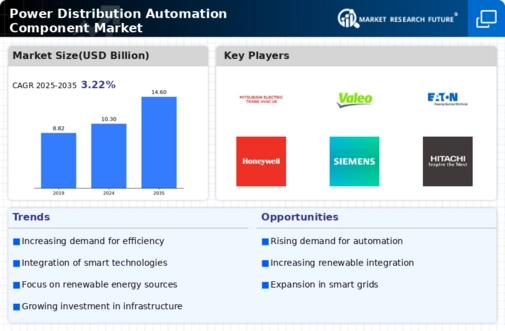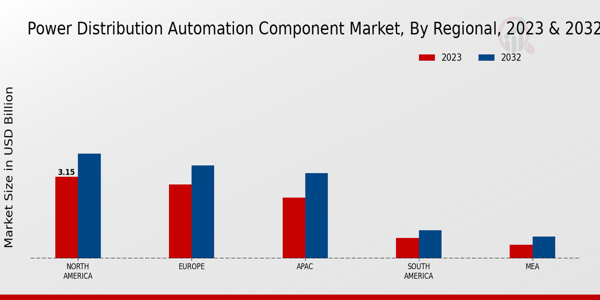Market Growth Projections
The Global Power Distribution Automation Component Market Industry is poised for substantial growth, with projections indicating a market value of 10.3 USD Billion in 2024 and an anticipated increase to 14.6 USD Billion by 2035. This growth trajectory suggests a compound annual growth rate (CAGR) of 3.22% from 2025 to 2035. The increasing demand for reliable power supply, coupled with technological advancements and supportive government policies, is expected to drive this expansion. As utilities invest in automation solutions to enhance grid efficiency and resilience, the market is likely to witness robust development.
Increased Focus on Grid Modernization
The increased focus on grid modernization is a critical driver of the Global Power Distribution Automation Component Market Industry. Aging infrastructure in many regions necessitates upgrades to ensure reliability and efficiency. Utilities are increasingly recognizing the importance of modernizing their grids to support the integration of new technologies and improve service delivery. This trend is expected to contribute to the market's growth, as investments in automation components become essential for enhancing grid performance and resilience. The ongoing modernization efforts are likely to create a favorable environment for market expansion.
Government Initiatives and Regulations
Government initiatives and regulations play a pivotal role in driving the Global Power Distribution Automation Component Market Industry. Many countries are implementing policies aimed at promoting renewable energy sources and enhancing grid resilience. For instance, regulatory frameworks that incentivize the adoption of smart grid technologies are becoming increasingly common. These initiatives not only support the transition to cleaner energy but also stimulate investments in automation components. As governments prioritize energy efficiency and sustainability, the market is likely to experience robust growth, aligning with global energy transition goals.
Rising Investments in Renewable Energy
The rising investments in renewable energy are significantly influencing the Global Power Distribution Automation Component Market Industry. As nations strive to reduce carbon emissions and transition to sustainable energy sources, the integration of renewable energy into existing grids becomes essential. This shift necessitates advanced automation solutions to manage the complexities associated with distributed energy resources. The market is expected to grow at a CAGR of 3.22% from 2025 to 2035, driven by the need for efficient power distribution systems that can accommodate increasing renewable energy capacities.
Growing Demand for Reliable Power Supply
The increasing demand for a reliable power supply is a primary driver of the Global Power Distribution Automation Component Market Industry. As urbanization accelerates globally, the need for uninterrupted electricity becomes paramount. This trend is particularly evident in developing regions where infrastructure is still evolving. The Global Power Distribution Automation Component Market is projected to reach 10.3 USD Billion in 2024, reflecting the urgency for advanced automation solutions to enhance grid reliability. Utilities are investing in smart grid technologies to mitigate outages and improve service quality, which further propels the market's growth.
Technological Advancements in Automation
Technological advancements in automation are reshaping the Global Power Distribution Automation Component Market Industry. Innovations such as IoT integration, artificial intelligence, and machine learning are enabling utilities to optimize their operations. These technologies facilitate real-time monitoring and predictive maintenance, thereby reducing operational costs and enhancing efficiency. As a result, the market is expected to grow significantly, with a projected value of 14.6 USD Billion by 2035. The adoption of these cutting-edge technologies is crucial for utilities aiming to modernize their infrastructure and meet the evolving demands of consumers.











